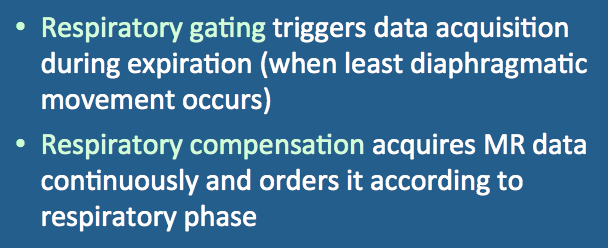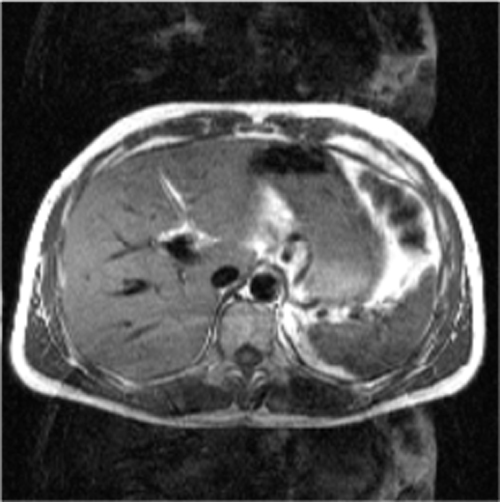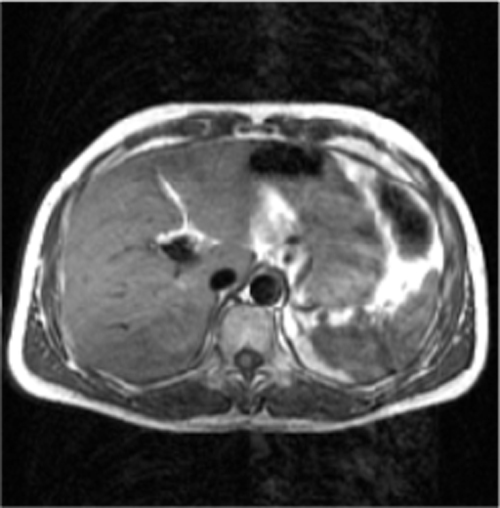Simple respiratory gating is a generally effective for reducing artifacts provided the breathing pattern is reasonably regular. Chest expansion is detected with a belt or bellows and displayed as a waveform on the operator's console. Points are selected on this waveform that trigger data acquisition. Typically the acquisition window is chosen during end expiration as this is the time when diaphragmatic motion is minimal. Because data acquisition occurs during only part of the respiratory cycle, simple respiratory gating may prolong imaging time by 50-300%.
In contrast to simple respiratory gating, respiratory compensation techniques acquire data continuously throughout the respiratory cycle. The low-amplitude phase-encode steps (very sensitive to motion) are acquired during expiration while the high-amplitude phase-encode steps (less sensitive to motion) are collected over the remaining part of each respiratory cycle.
The original method was developed by Picker scientists in the 1980's and was known as ROPE (Respiratory Ordered Phase Encoding). Today variants of this technique are offered by major vendors under names like "Respiratory Comp" (GE, Canon), "PEAR" (Phase Encoded Artifact Reduction, Philips), and "PERRM" (Phase Encode Reordering to Reduce Motion, Hitachi). These methods offer a good reduction of motion artifacts especially for short TR imaging. The time penalty is modest, perhaps only 10-15%, (excluding the time needed to fit and calibrate the respiratory bellows). A typical result is shown below.
Advanced Discussion (show/hide)»
Vendor variations and options for respiratory compensation exist. GE offers a "high sort" option that is similar to their "No Phase Wrap" technique. In GE's "high sort" the phase FOV and number of phase-encoding steps is doubled while the number of excitations (NEX) is cut in half. This has the effect of spreading the respiratory motion ghosts farther apart, many of which will now lie outside the displayed FOV. The downside of this technique is that vascular motion may increase.
References
Bailes DR, Gildendale DJ, Bydder GM et al. Respiratory ordered phase encoding (ROPE): a method for reducing respiratory motion artifacts in MR imaging. J Comput Assist Tomogr 1985; 9:835-838. (The original method. Most respiratory compensation techniques in use today employ a variant or ROPE known as COPE - central ordered phase encoding).
Ehman RL, McNamara MT, Pallack M, et al. Magnetic resonance imaging with respiratory gating: techniques and advantages. AJR Am J Roentgenol 1984; 143:1175-1182.
Lewis CE, Prato FS, Drost DJ, Nicholson RL. Comparison of respiratory triggering and gating techniques for the removal of respiratory artifacts in MR imaging. Radiology 1986; 160:803-810.
Bailes DR, Gildendale DJ, Bydder GM et al. Respiratory ordered phase encoding (ROPE): a method for reducing respiratory motion artifacts in MR imaging. J Comput Assist Tomogr 1985; 9:835-838. (The original method. Most respiratory compensation techniques in use today employ a variant or ROPE known as COPE - central ordered phase encoding).
Ehman RL, McNamara MT, Pallack M, et al. Magnetic resonance imaging with respiratory gating: techniques and advantages. AJR Am J Roentgenol 1984; 143:1175-1182.
Lewis CE, Prato FS, Drost DJ, Nicholson RL. Comparison of respiratory triggering and gating techniques for the removal of respiratory artifacts in MR imaging. Radiology 1986; 160:803-810.
Related Questions
How are cardiac and respiratory gating performed?
How are cardiac and respiratory gating performed?



